|
Page < 1 2 3 4 5 6 7 8 9 10 11 12 13 14 15 16 17 18 19 20 21 22 23 24 25 >
Show
in alphabetical order
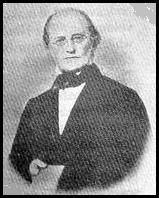 161. Eduard
Roeer (1805-1866) German Indologist, born in
Braunschweig Germany, made a name for himself on account of his research in
Hindu philosophy. His knowledge of philosophy and philology enabled him to
publish a number of valuable editions of philosophical texts. On Roeer's
suggestion the Asiatic Society of Bengal decided to publish the
Upanishads
together with Shankara's commentary. 161. Eduard
Roeer (1805-1866) German Indologist, born in
Braunschweig Germany, made a name for himself on account of his research in
Hindu philosophy. His knowledge of philosophy and philology enabled him to
publish a number of valuable editions of philosophical texts. On Roeer's
suggestion the Asiatic Society of Bengal decided to publish the
Upanishads
together with Shankara's commentary.
In a letter to Albrecht Weber, he
wrote, " Although the philological frame is very important, it is the
philosophy of the Hindus which interests me most in Sanskrit literature and it
has been my chief aim to bring about a better understanding of the same."
Roeer called the Upanishads,
"sublime emanations
of the Human mind" and
Shankara's commentary "a
shining example of comprehensive erudition, patient research and philosophical
acumen of the ancient Hindus".
(source: German
Indologists: Biographies of Scholars in Indian Studies writing in German
- By Valentine Stache-Rosen. p.5 - 6).
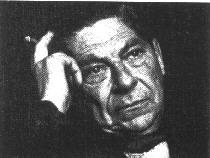 162
Arthur
Koestler, (1905-1983)
Hungarian-born British
novelist, journalist, and critic. He is best known for his novel Darkness at
Noon and The
Lotus and the Robot, in which he
examines Eastern mysticism
and wrote: 162
Arthur
Koestler, (1905-1983)
Hungarian-born British
novelist, journalist, and critic. He is best known for his novel Darkness at
Noon and The
Lotus and the Robot, in which he
examines Eastern mysticism
and wrote:
"Rome was saved in A.D. 408
by the ransom the Senate paid to Alaric the Goth; ever since, when Europe found
itself in an impasse or in a questing mood, it has turned yearningly to the land
of culinary and spiritual spices. "
"The greatest influence during the dark ages
was Augustine, who was influenced by Plotinus, who was influenced by Indian
mysticism.
"Long before Aldous Huxley found Yoga a remedy for our Brave New
World, Schopenhauer called the Upanishads the consolation of his life."
(source: Richer by Asia -
By Edmond Taylor, p. 7).
 163.
Jean Herbert (1897-
) famous Indianist, author of several books including Ganesha,
précédé d'une étude sur Dieu chez les Hindous, Spiritualité
hindoue, An
Introduction To Asia
and Vedantisme et vie pratique et autre études. 163.
Jean Herbert (1897-
) famous Indianist, author of several books including Ganesha,
précédé d'une étude sur Dieu chez les Hindous, Spiritualité
hindoue, An
Introduction To Asia
and Vedantisme et vie pratique et autre études.
He reminds us that:
"Many many centuries before us, India
had devised most of the philosophical systems which Europe experienced with
later."
"They contained, at least in its essence, the philosophy of the Greeks,
the Alexandrine mystique, the religious speculation of the Middle Ages, the
rationalism, of the XIXth century and even the most recent incarnations of
modern pantheism."
(source: Arise
O'
India - By Francois Gautier Har-Anand publications. p. 25)
 164.
The
Fourth Caliph, Ali bin Abi Talib (656
- 661
A.D.) had remarked: 164.
The
Fourth Caliph, Ali bin Abi Talib (656
- 661
A.D.) had remarked:
" The land where books
were first written and from where wisdom and knowledge sprang is India."
(Note: Many Islamic traditions
support the high standing of Indian culture with the Arabs. This shows the
affection and respect of early Muslims had for India. In any case, Caliph Umar,
was opposed to attacking India, even when he was told that "Indian rivers
are pearls, her mountains rubies, her trees perfumes," for he regarded
India as a country of complete freedom of thought and belief where Muslims and
others were free to practice their faith.
(source: Hindu
Muslim Cultural Accord - By Syed Mohamud
Bombay 1949 p. 18 and 21).
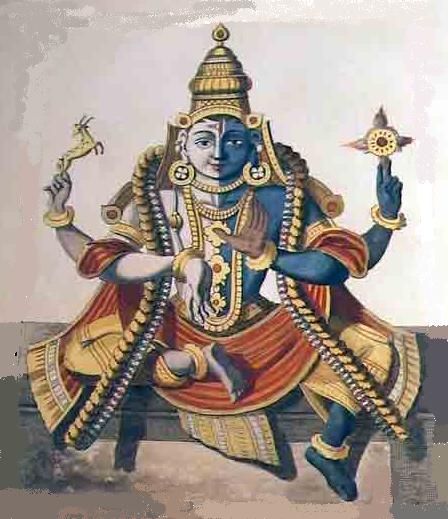
Lord Vishnu: Pierre Sonnerat's
engravings of Gods of India from his book - Journey to the Indies Eastern and
China.
"The underlying mood of
Hinduism is one of joyous
acceptance of the universe."
(image source: http://www.heatons-of-tisbury.co.uk/sonnerat.htm).
***
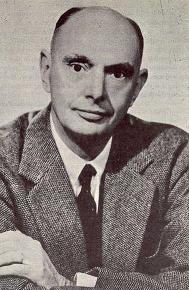 165. Edmond
Taylor ( ? ) author of Richer
By Asia has said: 165. Edmond
Taylor ( ? ) author of Richer
By Asia has said:
"The sophisticated
philosophies of the East (India) are even more abstract, subtle, and given to
the splitting of unsubstantial hairs than those of the West, but the emotional
basis of the oldest and richest Oriental religion - Hinduism - is perfectly
accessible, it sometimes seemed to me, than certain Christian moods."
"The underlying mood of
Hinduism is one of joyous
acceptance of the universe."
It is more richly endowed with gods and goddesses and all the trappings of
mythology than even the religion of ancient Greece, and this imaginative
exuberance is certainly connected with the pantheist emotional mood."
"More than any other
religion, Hinduism hangs upon the concept of wholeness, and the perception of
wholeness to the Hindu mind is the most joyous of all human experiences."
"the convictions of the
unity and orderliness of the universe is so strong in the devout Hindu that
nothing can shake it."
"Popular Hinduism, it is true, is more
richly endowed with gods and goddesses and all the trappings of mythology than
even the religion of ancient Greece, and this imaginative
exuberance is certainly connected with
the pantheist emotional mood, but it seems to be more a by-product than an
integral feature of it."
"The Higher Hindu sages have always
dispensed with all this objective paraphernalia while retaining their pantheist
hearts."
"The emotional root of
animism in Hindu village worship seemed to me to lie in a heightened sense of
reality rather than in unreality, in the use of marvel to express the marvelous ness
of simple reality in creating magical beings to explain the magic feel of normal
experience."
(source: Richer by Asia -
By Edmond Taylor
p. 297- 300).
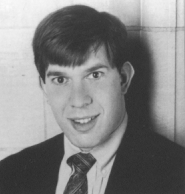 166.
Charles Seife ( ? ) a journalist with Science
magazine, has also written for New Scientist, Scientific American, The Economist,
Science, Wired UK, The Sciences, and
numerous other publications. He holds an M.S. in mathematics from Yale
University and his areas of research include probability theory and artificial
intelligence. 166.
Charles Seife ( ? ) a journalist with Science
magazine, has also written for New Scientist, Scientific American, The Economist,
Science, Wired UK, The Sciences, and
numerous other publications. He holds an M.S. in mathematics from Yale
University and his areas of research include probability theory and artificial
intelligence.
He is a
mathematician and science writer, author of
Zero: The
Biography of a Dangerous Idea,
says:
"Perhaps no one has embraced nothing as strongly
as the Indians who, Seife notes,
"never had a fear of the infinite or of
the void." Hinduism has embedded within it, a complex philosophy of
nothingness, seeing everything in the world as arising from the pregnant void,
known as Sunya."
The ultimate goal of the Hindu was to free
himself from the endless cycle of pain found in continual reincarnation and
reconnect with the Nothingness that is the source and fundament of the All.
For Indians, the void of Sunya was the very font of all potential; nothingness
was liberation. No surprise then that it is from this sophisticated culture that
we inherit the mathematical analog of nothing, zero. Like Sunya, zero is a kind
of place holder, a symbol signifying a pregnant space where any other number
might potentially reside."
(source: Zero: The Biography of a Dangerous Idea:
It's weird, it's counterintuitive and the Greeks hated it. Why did the Church
reject the use of zero? - http://www.calendarlive.com/top/1,1419,L-LATimes-Books-X!ArticleDetail-26133,00.html
http://www.salon.com/books/review/2000/03/03/seife/index.html).
167. Bhagwan S. Gidwani
( ? ) author of The Return of the Aryans,
has correctly
shows that Hinduism is based on supremacy of conduct, and not creed. His view
also is simple and forthright --that Hinduism is the one religion that honors
and respects human rights. Most other religions consign non-believers to hell,
everlasting. Hinduism has room for non-believers, agnostics and atheists. What
Hinduism seeks is purity of conduct, and not creed.
 In 'The Return of the Aryans' he clarifies that Bharat
who composed the Song of the Hindu,
was the 19th Karkarta (Elected Supreme Chief) of the Hindu clan from 5,106 BC.
He retired as a hermit at the age of sixty. Long after he retired, the name Bharat
Varsha was given to the country to honor his memory. In 'The Return of the Aryans' he clarifies that Bharat
who composed the Song of the Hindu,
was the 19th Karkarta (Elected Supreme Chief) of the Hindu clan from 5,106 BC.
He retired as a hermit at the age of sixty. Long after he retired, the name Bharat
Varsha was given to the country to honor his memory.
The book unfolds the drama
of the birth and beginnings of Hinduism prior to 8,000 BC, and its early roots
of Sanatana Dharma and Sanatanah. It also tells the story of how in
5,000 BC, the Aryans originated from India,
and why they moved out of their homeland; their trials and triumphs, battles and
bloodshed, adventures and exploits in Europe and elsewhere, including Russian
Lands, Finland, Lithuania, Scandinavia, Italy, Greece and Germany; and finally
their return to the home-town and
heritage of Bharat Varsha.
The
Song of the Hindu
"Our desires have grown
immeasurable. But they should be desires to give, not merely to receive, to
accept and not to reject; to honour and respect, not to deny or belittle...
"God's gracious purpose
includes all human beings and all creation"
"For God is the Creator; and God is the Creation...
"Each man has his own stepping stones to reach the
One-Supreme..."God's grace is withdrawn from no one; not even from those
who have chosen to withdraw from God's grace..."How does it matter what
idols they worship, or what images they bow to, so long as the conduct remains
pure…"It is conduct then - theirs and ours - that needs to be purified.
"There can be no
compulsion; each man must be free to worship his gods as he chooses...
"Does every Hindu worship
all the gods of all the Hindus? No, he has a free will; a free choice" A
Hindu may worship Agni (fire), and ignore other deities. Do we deny that he is a
Hindu?
..."Another may worship
God, through an idol of his choosing. Do we deny that he is a Hindu?. "Yet
another will find God everywhere and not in any image or idol. Is he not a
Hindu?..."He who was Karkarta before me was a Sun-worshiper. Did the
worshipers of Siva ever say that he was not a good Hindu? ..."Do the
worshipers of Vishnu feel that he who worships before the image of Brahma is not
a Hindu?...
 "How can a scheme of
salvation be limited to a single view of God's nature and worship? "Is then
God, not an all-loving Universal God?..."Clearly then, he who seeks to deny
protection to another on the basis of his faith, offends against the Hindu way
of life, and denies an all-loving God... "Those who love their own sects,
idols and images more than Truth, will end up by loving themselves more than
their gods.." He who seeks to convert another to his own faith, offends
against his own soul and the will of God and the law of humanity..."In the
Kingdom of God, there is no higher nor lower. The passion for perfection burns
equally in all, for there is only one class even as there is only one
God..."The Hindu way of life?... Always it has been and always it shall
be...that God wills a rich harmony - not a colorless uniformity..."A Hindu
must enlarge the heritage of mankind "For
a Hindu is not a mere preserver of custom. "For a Hindu is not a mere
protector of present knowledge... "How can a scheme of
salvation be limited to a single view of God's nature and worship? "Is then
God, not an all-loving Universal God?..."Clearly then, he who seeks to deny
protection to another on the basis of his faith, offends against the Hindu way
of life, and denies an all-loving God... "Those who love their own sects,
idols and images more than Truth, will end up by loving themselves more than
their gods.." He who seeks to convert another to his own faith, offends
against his own soul and the will of God and the law of humanity..."In the
Kingdom of God, there is no higher nor lower. The passion for perfection burns
equally in all, for there is only one class even as there is only one
God..."The Hindu way of life?... Always it has been and always it shall
be...that God wills a rich harmony - not a colorless uniformity..."A Hindu
must enlarge the heritage of mankind "For
a Hindu is not a mere preserver of custom. "For a Hindu is not a mere
protector of present knowledge...
"Hinduism
is a movement, not a position; a growing tradition and not a fixed
revelation..."A Hindu must grow and evolve,
with all that was good in the past, with all that is good in the present, and
with all goodness that future ages shall bring. "Yet he remains a
Hindu."
"Hinduism
is the law of life, not a dogma; its aim is not to create a creed but character,
and its goal is to achieve perfection through most varied spiritual knowledge
which rejects nothing, and yet refines everything, through continuous testing
and experiencing..."
"Yet he must remain strong and united, for a
Hindu must know that not an external, outside force can ever crush him, except
when he is divided and betrays his own..."What then is the final goal of
the Hindu? Through strength, unity, discipline, selfless work, to reach the
ultimate in being, ultimate in awareness and ultimate in bliss, not for himself
alone, but for all..."This was the silent pledge that our ancient ancestors
had taken, when they called themselves the Hindu…"If I cannot abide by
that pledge, how can I retain the right to call myself a Hindu?"
Gidwani
meets another issue headlong, and demonstrates clearly that caste system was never
a tenet
of the Hindu faith. Tracing the development of caste system, he shows that it is
in fact antagonistic to the Hindu religion, and its ideals.
(source:
The Return of the Aryans
- By B S Gidwani
p. 65 & 82-83. For more quotes by Gidwani, please refer to the chapter
Introduction
to Hinduism. For information on the caste system, refer to
chapter on Caste System).
For the Song
of the Hindu refer to Sindhulogy.org
- http://www.sindhulogy.org/index.aspx?page=Content/Music.
168.
Roger-Pol Droit (
? ) French philosopher
and journalist has remarked that the philosophy of the Vedas and spirituality,
seems to disappeared from the consciousness of Europeans and the references to
the Indian culture after the collapse of Nietzsche. Since then, Europe has
practiced what he calls "helleno-centrism" (Greece-centered)
education, which means that the West believes that all philosophical systems
started with Greece and that there was nothing worth the name before them.
In his remarkable book, L'oubli
de l"Inde :
une amnâesie philosophique
(The
forgetting of India) Droit
explains the reasons of this "intellectual amnesia".
One reason was due to the German philosopher Hegel, who did not discover the
Greeks, but created them and made up for them a destiny and thoughts which they
did not always have."
In India, things add up, they don't complete to
replace each other. It is this gift for coexistence that we have to learn from
this exuberant yet impassive civilization.
(source: Arise
O' India - By Francois Gautier p. 26 and
The
Genius of India - By Guy Sorman - Macmillan India Ltd. 2001. ISBN
0333 93600 0 back cover).
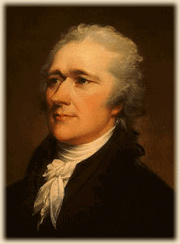 169.
Alexander Hamilton
(1757-1804) aide-de-camp to George Washington and first secretary of the
Treasury, epitomized this attitude in these words: 169.
Alexander Hamilton
(1757-1804) aide-de-camp to George Washington and first secretary of the
Treasury, epitomized this attitude in these words:
"When we read in the
valuable production of those great Oriental scholars...those of a Jones, a
Wilkings, a Colebrooke, or a Halhed, - we uniformly
discover in the Hindus a nation, whose polished manners are the result of a mild
disposition and an extensive benevolence."
(source: The
Invasion That Never Was - By Michel Danino and Sujata Nahar p. 17).
 170. Professor Arthur Holmes
(1895 -1965) geologist, professor at the University of Durham. He
writes regarding the age of the earth in his great book, The
Age of Earth (1913) as
follows: 170. Professor Arthur Holmes
(1895 -1965) geologist, professor at the University of Durham. He
writes regarding the age of the earth in his great book, The
Age of Earth (1913) as
follows:
"Long before it became a
scientific aspiration to estimate the age of the earth, many elaborate systems
of the world chronology had been devised by the sages of antiquity. The
most remarkable of these occult time-scales is that of the ancient Hindus, whose
astonishing concept of the Earth's duration has been traced back to Manusmriti,
a sacred book."
(source: Hinduism
and Scientific Quest - By T. R. R. Iyengar
p. 20).
171. J.
Ovington ( ? ) Chaplain to the British King, the seventeenth-century
English traveler, wrote in his A
Voyage to Surat in the Year 1689, that:
" Of all the regions of the Earth (India is)
the only Public theatre of Justice and Tenderness to Brutes and all living
creatures." He also found that, because of their diet, the Hindus kept a
comely and proportionate body and lived a long life. The simple and meatless
food made their thoughts 'quick and nimble,' their 'comprehension of things'
easier and developed in them a spirit of fearlessness."
(source: Indian
Vegetarian Cookery - By Jack Santa Maria p. 17).

The magnificent Rewa gate in
Madhya Pradesh, India.
For
more refer to chapter on Greater
India: Suvarnabhumi and Sacred
Angkor
***
 172.
Sir Thomas Munro (1761-1827) held various
posts in the colonial administration of India, served as brigadier-general
during the third Maratha War (1817–18) and was appointed Governor of Madras in
1819. A distinguished Governor of Madras, in a statement made by him before a
Committee of the House of Commons, in 1813, ("Hansard's Debates, April 12),
he noted: 172.
Sir Thomas Munro (1761-1827) held various
posts in the colonial administration of India, served as brigadier-general
during the third Maratha War (1817–18) and was appointed Governor of Madras in
1819. A distinguished Governor of Madras, in a statement made by him before a
Committee of the House of Commons, in 1813, ("Hansard's Debates, April 12),
he noted:
"If a good system of agriculture, unrivalled
manufacturing skill, a capacity to produce whatever can contribute to
convenience or luxury, schools established in every village for teaching,
reading, writing and arithmetic; the general practice of hospitality and charity
among each other; and above all, a treatment of the female sex full of
confidence, respect, and delicacy, (if all these) are among the signs which
denote a civilized people, then the Hindus, are not inferior to the nations of
Europe; and if civilization is to become an article of trade between England and
India, I am convinced that England will gain by the import cargo."
(source:
India
in Bondage: Her Right to Freedom - By Rev. Jabez T. Sunderland p.324-325) and The
Invasion That Never Was - By Michel Danino and Sujata Nahar p. 17).
173. Austin
Coates ( ? ) son
of composer Eric Coates, Assistant Colonial Secretary and a magistrate in Hong
Kong during the World War II, and First Secretary to the British High Commission
in Kaula Lumpur and Penang in 1959-62).
" What we generally fail to realize is that in
talking today to the Indians we are face to face with the direct descendants, as
often as not, of people who were contemporaries of Ancient Egypt, and whose
present culture, in most of its main essentials, is nearly the same as it was
then, and is in any event directly descended from that age, and even possibly
before it."
(source: China,
India and the Ruins of Washington - By Austin Coates
p- 20)
 174.
Kanchan Gupta ( ?) Political commentator
for the English language media. He has observed that: 174.
Kanchan Gupta ( ?) Political commentator
for the English language media. He has observed that:
" One of the great strengths of Hinduism is that it is not
an organized religion rigidly structured on verse and chapter of a single holy
book. Hinduism accommodates in its fold both believers and
non-believers, iconoclasts and idol-worshippers, liberals and conservatives. It
is at once amorphous and intense, reverent and irreverent, ancient and modern.
It is this strength that makes Hinduism a living religion, a
life-sustaining experience. "
(source:
Hindu
tele-evangelists - By Kanchan Gupta - Sunday Pioneer Date: December 5, 2004).
175.
Sa`Id
Al-Andalusi
(1029 -1070) Islamic scholar, who was a
prolific author and in the powerful position of a judge for the king in Muslim
Spain. He focused
on India as a major center for science, mathematics and culture.
He wrote Kitab Tabaqat al-Uman or "Book
of the Categories of Nations," which recorded the contributions to science
of all known nations. He has said:
"The Indians among all
nations, through many centuries and since antiquity, have been the source of
wisdom, fairness and moderation. They are creators of sublime thoughts,
universal apologues, rare inventions and remarkable concepts."
 "... They referred to the king of India as the "king of wisdom"
because of the Indians' careful treatment of 'ulum [sciences] and all the
branches of knowledge.
"... They referred to the king of India as the "king of wisdom"
because of the Indians' careful treatment of 'ulum [sciences] and all the
branches of knowledge.
"The Indians, known to all nations for many centuries, are the metal
[essence] of wisdom, the source of fairness and objectivity. They are people of
sublime pensiveness, universal apologues, and useful and rare inventions."
“The
first nation (to have cultivated science) is India. This is a powerful nation
having a large population, and a rich kingdom. India is known for the wisdom of
its people. Over many centuries, all the kings of the past have recognized the
ability of the Indians in all the branches of knowledge.”
“The
Indians, as known to all nations for many centuries, are the metal (essence) of
wisdom, the source of fairness and objectivity. They are peoples of sublime
pensiveness, universal apologues, and useful and rare inventions.”
“To
their credit, the Indians have made great strides in the study of numbers and of
geometry. They have acquired immense information and reached the zenith in their
knowledge of the movements of the stars (astronomy) and the secrets of the skies
(astrology) as well as other mathematical studies. After all that, they have
surpassed all the other peoples in their knowledge of medical science and the
strengths of various drugs, the characteristics of compounds and the
peculiarities of substances [chemistry].”
“Their
kings are known for their good moral principles, their wise decisions, and their
perfect methods of exercising authority.”
“What
has reached us from the work of the Indians in music is the book… [that]
contains the fundamentals of modes and the basics in the construction of
melodies.”
“That
which has reached us from the discoveries of their clear thinking and the
marvels of their inventions is the (game) of chess. The Indians have, in the
construction of its cells, its double numbers, its symbols and secrets, reached
the forefront of knowledge. They have extracted its mysteries from supernatural
forces. While the game is being played and its pieces are being maneuvered,
there appear the beauty of structure and the greatness of harmony. It
demonstrates the manifestation of high intentions and noble deeds, as it
provides various forms of warnings from enemies and points out ruses as well as
ways to avoid dangers. And in this, there is considerable gain and useful
profit.”
(source: The
Categories of Nations -
By Said
al-Andalusi. A translation
was published by University of Texas Press: “Science in the Medieval World”.
This is the first English translation of this eleventh-century manuscript.
Quotes are from Chapter V: “Science in India”). A Concise
History of Science in India eds. D. M.
Bose, S. N. Sen & B. V. Subbarayappa. New Delhi. Indian National
Science Academy, 1989), p. i and The
Invasion That Never Was - By Michel Danino and Sujata Nahar p. 16).
(source:
How
'Gandhara' became 'Kandahar'
- By Rajiv Malhotra and The
Making of the Indo-Islamic World. Volume I – Early Medieval India and the
Expansion of Islam 7th-11th Centuries - By Andre Wink. Oxford University Press, New Delhi 1999. p.112
-193).
 176.
Gustav Oppert
(1836-1908) born in Hamburg, Germany, he taught Sanskrit and comparative
linguistics at the Presidency College, Madras for 21 years. He was the Telugu
translator to the Government and Curator, Government Oriental Manuscript
Library. He writes of his high esteem for the Bharatas, the original inhabitants
of India: 176.
Gustav Oppert
(1836-1908) born in Hamburg, Germany, he taught Sanskrit and comparative
linguistics at the Presidency College, Madras for 21 years. He was the Telugu
translator to the Government and Curator, Government Oriental Manuscript
Library. He writes of his high esteem for the Bharatas, the original inhabitants
of India:
" I venture to suggest that
the inhabitants of this country would do well if they were to assume the
ancient, honorable, and national name of Bharata, remembering that India has
become famous as Bharatvarsa, the land of the Bharats."
(source: German
Indologists: Biographies of Scholars in Indian Studies writing in German
- By Valentine Stache-Rosen p.81-82).
177. Shri V.
Shankar ( ? ) ICS (Retd.) former Defense Secretary and earlier Private Secretary to the late
Sardar Patel.
" It is nothing short
of a miracle that the Hindu society and Hindu Dharma have survived so long in
spite of repeated aggressions. The secret of our continued existence lies in the
fact that our culture has the requisite vitality to influence and absorb outside
elements." “India will be saved by Dharma,
not by Political maneuvers.” Regarding marriage within caste, he says:
"It is human nature to marry some one who is from a similar
background. Everyone does it. A Sunni Muslim wants to marry only a Sunni
Muslim. How about Jews, Catholics, Whites, Chinese? They all advertise and
seek only their own kind. It is universal. A honest narrow minded person
creates less harm to the society than a pseudo broad minded person. Are you
saying an fifty year old white American who marries a twenty year old mail
order bride from Phillipines is better than the typical Indian who marries
within his sub caste?"
178. Vincent
Arthur Smith (1848 - 1920)
British
historian, and author of The
Oxford History of India, says:
"
India ...beyond all doubt possesses
a deep underlying fundamental unity, far more profound that that produced either
by geographical isolation or by political suzerainty. That unity transcends the
innumerable diversities of blood, color, language, dress, manners and
sect."
"Hinduism
has never produced an exclusive, dominant, orthodox sect, with a formula of
faith to be professed or rejected under pain of damnation."
(source: Essays
on National Idealism - By Ananda K. Coomaraswamy
p. 131).
Regarding astronomy,
he wrote:
"The most
systematic record of Indian Historical tradition is that preserved in the
dynastic lists of the Puranas, five out of the eighteen works of this class,
namely the Vayu, Matsya, Vishnu, Bramhanda and Bhagvata contain such lists. The
Brahmanda and the Vayu as well as the Matsya, which has large later additions,
appear to be the earliest and most authoratative."
(source: Hinduism
in the Space Age
- by E. Vedavyas p. 108).
 179.
Richard
Bernstein ( ? )
a former New York Times
correspondent in China, book critic, author of The
book, Ultimate
Journey 179.
Richard
Bernstein ( ? )
a former New York Times
correspondent in China, book critic, author of The
book, Ultimate
Journey
On
a visit to India, was struck by how Hinduism is so detached from materialistic
values. A meeting with the Shankaracharya of Kanchipuram, a leading figure of
Hinduism, was particularly enlightening. "With his entourage, the kind of
conspicuous anti-materialism of it, really kind of brought home to me that
Hinduism really is an ascetic religion," he said.
"It
is a religion which encourages people to look into themselves for truth as the
goal of life rather than to get rich or to acquire power."
As evidence of this, Bernstein compared the Shankaracharya of Kanchipuram to the
Pope, who, he said, holds a comparable spiritual position in Roman Catholicism. Yet,
"their appearance to the world is utterly, utterly different", he
said. "One is surrounded by the trappings of splendor -- vast cathedrals
and palaces and fabulous museums full of zillion-dollar paintings and
sculptures... and all the trappings of power.
I couldn't show up in Rome and say 'Gee, could I come and see the Pope?' and be
welcomed, but there I was in India, asking if I could meet the Shankaracharya of
Kanchipuram and I was welcomed."
"One
of the elements of India that is most difficult for the Western mind to grapple
with is the depth and power of Hindu spirituality," Bernstein said.
"It's both troubling and inspiring that so many people who are so poor have
time and energy for very, very thorough-going, intense and profound spiritual
searches."
(source: Rediff.com
- Down The Road With Huien Tsang
- http://www.rediff.com/news/2001/may/23usspec.htm).
 180.
Dr.
Ernest Binfield Havell (1861-1934)
principal to the Madras College of
Art in the 1890s and left as principal of the Calcutta College of Art some 20
years later. He wrote several books, including his
book, Indian
Architecture - Its Psychology, Structure and History from the First Mohammedan
Invasion to the Present Day. He has said: 180.
Dr.
Ernest Binfield Havell (1861-1934)
principal to the Madras College of
Art in the 1890s and left as principal of the Calcutta College of Art some 20
years later. He wrote several books, including his
book, Indian
Architecture - Its Psychology, Structure and History from the First Mohammedan
Invasion to the Present Day. He has said:
"India,
whether regarded from a physical or intellectual stand-point, is herself the
great exemplar of the doctrine of the one in the many, which her philosophers
proclaimed to the world."
(source:
The
History of Aryan Rule in India - E. B. Havell).
"In
India, religion is hardly a dogma, but a working hypothesis of human conduct,
adapted to different stages of spiritual development and different conditions of
life. A dogma might continue to be believed in, isolated from life,
but a working hypothesis of human conduct must work and conform to life, or it
obstructs life. The very raison d'etre of such a hypothesis is its workableness,
its conformity to life, and its capacity to adapt itself to changing conditions.
So long as it can do so it serves its purpose and performs its allotted
function. when it goes off at a tangent from the curve of life, loses contact
with social needs, and the distance between it and life grows, it loses all its
vitality and significance."
(source:
The
Discovery of India - By Jawaharlal Nehru
Oxford University Press. 1995. p. 182).
"It was India, not Greece, that taught Islam
in the impressionable years of its youth, formed its philosophy and esoteric
religious ideals and inspired its most characteristic expression in literature,
art and architecture."
(source: The
History of Aryan Rule in India - E. B. Havell).
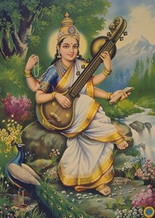 Comparing the European and Hindu art, E. B. Havell
says: Comparing the European and Hindu art, E. B. Havell
says:
"European art has, as it were its wings
clipped: it knows only the beauty of earthly things. Indian art, soaring into
the highest empyrean, is ever trying to bring down to earth something of the
beauty of the things above."
Just as angels are given wings, or saints halos,
or just as the Holy Spirit was portrayed as a dove, so Shiva or Vishnu were
given extra arms to hold the symbols of their various attributes, or extra heads
for their different roles. Havell showed how consummately the Indian artist
could handle movement. Taking the example of the famous Nataraja (dancing Shiva)
bronzes of south India, he first explored its symbolism. No work of Indian art
is without a wealth of allegory and symbol, ignorance of which was, and still
is, a major stumbling block for most non-Indians. The Nataraja deals with the
divine ecstasy of creation expressed in dance.
"Taking the example of the famous Nataraja (dancing Shiva)
bronzes of south India, he first explored its symbolism. No work of Indian art
is without a wealth of allegory and symbol, ignorance of which was, and still
is, a major stumbling block for most non-Indians. The Nataraja deals with the
divine ecstasy of creation expressed in dance. '
Says
Havell:
“The design of the Kailasa
remained, for all time, the perfect model of a Shivalinga, - the temple
craftsman’s vision of Shiva’s wondrous palace in his Himalayan glacier,
where in his Yogi’s cell the Lord of the Universe, the great magician,
controls the cosmic forces by the power of thought; the holy rivers, creating
the life in the world below, enshrined in His matted locks; Parvati, His other
Self, the Universal Mother, watching by His side.”
(source: Indian
Sculpture and Painting - By
Ernest Binfield Havell Elibron
Classics reprint. Paperback. New. Based on 1908 edition by John Murray, London.
p.24
- 69).
(source: The Splendour That
Was 'Ind' - By K T Shah p. 153-154). For more Mr. Havell refer to chapter on Hindu
Art).
Top
of Page
Show
in alphabetical order
Quotes181_200
 

Page < 1 2 3 4 5 6 7 8 9 10 11 12 13 14 15 16 17 18 19 20 21 22 23 24 >
|